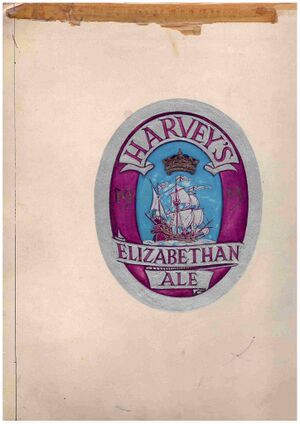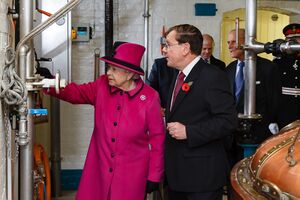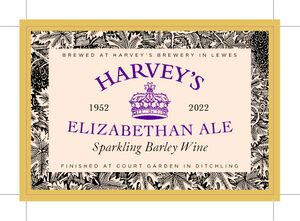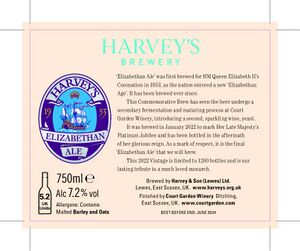Elizabethan Ale – a Beer of its Time
Elizabethan Ale
A Beer of its Time
By
Miles Jenner Head Brewer & Managing Directory of Harvey & Son Ltd, Lewes
Coronations evoke conflicting emotions – the anticipation of a new era in the nation’s history and a strange nostalgia for the past.
In 1952, King George VI died and his eldest daughter, Princess Elizabeth, became our queen. I don’t believe it was seen as the passing of a Georgian era but a young queen bearing the name of one of her most illustrious predecessors undoubtedly invited comparisons with a bygone age and a monarch who saw herself wedded to her country. Elizabeth I had been named ‘Gloriana’ and, for many contemporaries, her long reign had indeed been glorious.
My father, as well as being an astute businessman and an excellent brewer, was an incurable romantic. The Coronation presented an opportunity to brew a barley wine which, if successful, could remain in production.
Barley Wines were perceived as strong, dark ales and this was to be no exception. It would be brewed in tandem with the ‘Old’ and ‘Mild’, utilising a well-established system of parti-gyle brewing by which a number of different beers can be produced from a single mash on the day of brewing. The ‘Old Ale’ had taken first prize in its class at the recent Brewers’ Exhibition at Olympia and was the first award the company had received in its long history. These were stirring times.
The original brew was mashed on 28th January 1953 and was entered in our Brewing Journal as ‘Coronation Ale’.
The grist of mild, pale, crystal, black and enzymic malts, together with flaked barley, was appropriate for the task in hand. Additional proprietary brewing sugars were dissolved and added to the coppers. Fifteen barrels of the strong, first copper worts were diverted to one fermenting tun, at an original gravity of 1092 degrees, thirty pounds of yeast were pitched and fermentation of the new barley wine got underway.
The remaining first and second copper worts were apportioned into two further vessels to produce twenty barrels of ‘Old Ale’ (1043 OG) and forty barrels of ‘Mild Ale’ (1030 OG).
The Coronation was to take place in June. While the resultant beer underwent conditioning and cold storage, thoughts turned to the creation of an appropriate label. The romance of a new era called for a theme that would evoke the spirit of the times and ‘Elizabethan Ale’ seemed most apt. A local friend and artist, Stephen Blundell, was commissioned with the task of designing an oval depiction of Drake’s ship ‘The Golden Hind’ afloat, surmounted by the Tudor crown. Alongside this reference to the past, the prominent inclusion of the year ‘1953’ would signify our entry to a new ‘Elizabethan’ Age.
Label design was an art of its own at a time when printing was not as simple or cost effective as it is today. Every colour employed came at a greater cost. It was necessary to utilise as few as possible on a white background. Blue, purple and gold combined to good effect and ‘Elizabethan Ale’ was launched. It was packaged in ‘nip’ bottles (170ml) on account of its strength (approximately 8.0% abv) and a purple ‘Crown Cork’ closure or ‘bottle top’ sealed the deal.
Despite the popularity of the brand, the 1950s witnessed an increased public preference towards lighter coloured beers. In the mid-1950s, our production of draught beer was split 74% Mild : 26% Bitter. By the mid-1960s it was 49% Mild : 51% Bitter. In order to enhance its appeal, ‘Elizabethan’ became progressively lighter in colour. Flaked maize replaced flaked barley, the lightest pale ale malts became the mainstay of the grist and Invert No.1 Sugar was added to the copper. The weaker worts were destined for Pale Ale production. Strangely, the change in malts may have produced a beer that more closely resembled strong ales brewed during the Sixteenth Century.
There was a resurgence of interest. The beer even entered local public bar parlance: a nip bottle in a glass was referred to as a QE1, two bottles a QE2 and, for those who lamented the passing of the original brew, one bottle topped up with Old Ale became a ‘Queen Mother’. More often than not, customers simply asked for ‘a Lizzie’. We received a charming letter from a couple who “had been married for more than a decade but had not been blessed with children”. It informed us that following a pub lunch at Bodiam, washed down with ‘Elizabethan Ale’, they had found a shaded area in the adjoining hop gardens to sleep off its effects. Nine months later, their daughter had been born and duly christened ‘Elizabeth’.
In 1968, the new, distinctly hopped, ‘Elizabethan Ale’ took first prize in its class at the Brewers’ Exhibition and went on to be awarded the Championship Runner-Up Gold Medal.
Jubilee celebrations saw special editions of ‘Elizabethan’ brewed. For the Silver Jubilee, the original gravity was increased to 1107 degrees. By the time of the Golden and Diamond Jubilees, there had been a resurgence of interest in dark beers and we reverted to the original recipe to give drinkers a nostalgic insight to beer that had been drunk at the time of the coronation. For the latter jubilee, we parti-gyled again to produce a draught 5.0% abv beer on tap. By coincidence, we were using hops from one of the self-same growers who had featured in the 1953 brew.
In 2013 Queen Elizabeth II and Prince Phillip visited the brewery during what was to prove their last tour of Sussex. On the mash tun floor, the Queen started the Steel’s masher to initiate a brew of ‘Elizabethan Ale’ before signing our Brewing Journal beneath the details of the grist that continued to flow into the vessel. A walk through the copper house, fermenting room, racking cellar and bottling hall followed. Staff had congregated at different points en route and spontaneous applause greeted the royal progress. Freshly labelled bottles of ‘Elizabethan Ale’ were being packaged at the end of the line.
The Royal party joined guests of the Lord Lieutenant of East Sussex at a luncheon, hosted by the company, in a marquee that had been erected in the brewery yard. The eighty guests, representing voluntary sector organisations and those involved in public service, enjoyed a meal comprised entirely of Sussex fayre including Brill from Newhaven fish market, Sussex Best Bitter and Sussex wines. The royal visitors left Lewes through streets thronged with well-wishers. As they departed the Royal Standard, which had flown over the brewhouse as they arrived, was duly lowered.
As the Platinum Jubilee beckoned, a decade on, we started to plan a very special celebratory version of the brew – this was to be a platinum jubilee for the beer in its own right, as well as a tribute to our longest reigning monarch.
Our goal was to create a vintage brew in a bottle that reflected the product’s renown. If it was to live up to its description as the ‘Champagne of Beers’, it seemed appropriate that it should appear in a similar format.
It was decided to approach a Sussex wine producer – Court Garden Vineyard at Ditchling – with a view to creating a collaborative brew. Established by the Corney family in 2005, this 6.8 hectare estate had established a reputation for excellence and their wines had proved exceptionally popular in our brewery shop. The site had been a farm, known as the Manor of Ditchling Garden, in Saxon times and had later been held by the Cluniac Priory in Lewes. Following the Reformation, it had become the property of the Crown and acquired the name ‘Court Garden’.
We were met with an enthusiasm for the project equal to our own and the collaboration became an adventure that we shared during the ensuing months.
Following secondary fermentation at the brewery, the finished beer was subjected to further conditioning and maturation at the vineyard, where a sparkling wine yeast was introduced. The resultant bottles would undergo a traditional riddling process before being corked, wired and labelled. It would be packaged as they would their most treasured vintage.
The process took far longer than we anticipated, with the result that we missed the planned release date in June 2022. We had discovered, after the riddling process, that some yeast remained in the bottles. The likelihood of on-going secondary fermentation deemed it expedient to pasteurise the entire batch. Quality was unimpaired, the beer softened slightly and the yeast readily dropped out of suspension. Just as we were preparing to launch the final product, we learnt the sad news that the Queen had died.
Approximately 1200 bottles had been produced and we decided, as a mark of respect, this would be the very last ‘Elizabethan Ale’ that we would brew. It was to be our final tribute to a much loved monarch.
The commemorative label proved more problematic than we had envisaged. There are strict rules that must be adhered to when depicting a crown on any label. Having carefully selected one of the permitted options from Appendix 6 of the Royal Warrant Holders Association instructions, we submitted a proof of the front label with the aforementioned crown and the back label, which contained a facsimile of the label that had been created in 1953. We were somewhat aghast to receive a very charming note saying that, while the front label was entirely satisfactory, the crown depicted on the facsimile did not comply – could it be replaced or removed?
We replied, explaining that the back label contained the original artwork that had been designed at the time of the coronation. Would it create too much of a problem on this last outing? If so, we would of course attend to it but it would be a sad departure. We received a gracious and understanding response - ‘Please carry on as planned on that basis’.
It will be strange to part company with our ‘Elizabethan’ but it has spawned other barley wines – our dark Christmas Ale bears more than a passing similarity to the original concept and our pale Easter Ale has many attributes of the later versions. There are a few bottles of the original 1953 bottling remaining. I was born in 1952 and my father laid down a quantity of unlabelled half pint bottles in anticipation of my 21st birthday. I have opened one on each successive decade. They have acquired a sherry like quality and the cork lining of the crown has deteriorated considerably. I intend to do the same for my grandson, born shortly before the Queen Elizabeth’s Platinum Jubilee, and will be cellaring the collaborative brew in the hope that he will enjoy it eighteen years on.
We are currently brewing a Coronation Ale for HM King Charles III. Again, we have looked to the dawning of a new era and have used a friend and local artist to reflect the theme.
‘Carolean Crown’, however, is not a strong barley wine. It is of a more modern genre – pale and distinctly ‘hoppy’, it is brewed with UK barley together with English and Commonwealth hops. The draught version is 3.7% abv. The bottled version (4.0% abv) is blended with a portion of ‘Elizabethan Ale’, aged in oak casks, to mark the transition to a second Carolean Era. The label depicts the young Charles Stuart hiding from Commonwealth troops in an oak tree and is taken from Julian Bell’s design for the inn sign of our public house ‘The Royal Oak’ in Tabard Street, London.
A final note on ‘the last Elizabethan’, our collaborative venture with Court Garden:
“It has all the attributes of a strong beer that has been aged and matured. Final fermentation in the bottle has left a tight sediment of yeast and the beer should be poured carefully. A balanced barley wine - the residual sweetness is not cloying and is matched by the hop resins to produce a smooth, lasting finish. The bubbles are delicate yet vibrant and the beer has a white, creamy head that persists. It can be served chilled or at cellar temperature.”
Gloriana






